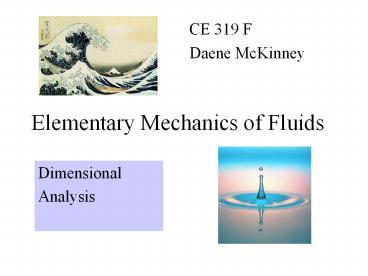Elementary Mechanics of Fluids - PowerPoint PPT Presentation
Title:
Elementary Mechanics of Fluids
Description:
Determine the required number of dimensionless parameters (n j) ... Mach Number (inertial to elastic forces) Important in problems with compressibility effects ... – PowerPoint PPT presentation
Number of Views:85
Avg rating:3.0/5.0
Title: Elementary Mechanics of Fluids
1
Elementary Mechanics of Fluids
- CE 319 F
- Daene McKinney
Dimensional Analysis
2
Dimensional Analysis
- Want to study pressure drop as function of
velocity (V1) and diameter (do) - Carry out numerous experiments with different
values of V1 and do and plot the data
p1
p0
V1
V0
A0
A1
5 parameters Dp, r, V1, d1, do
2 dimensionless parameters Dp/(rV2/2), (d1/do)
Much easier to establish functional relations
with 2 parameters, than 5
3
Exponent Method
Force F on a body immersed in a flowing fluid
depends on L, V, r, and m
n 5 No. of dimensional parameters j 3 No. of
dimensions k n - j 2 No. of dimensionless
parameters
F L V r m
MLT-2 L LT-1 ML-3 ML-1T-1
Select repeating variables L, V, and r Combine
these with the rest of the variables F m
Reynolds number
4
Exponent Method
F L V r m
MLT-2 L LT-1 ML-3 ML-1T-1
Dimensionless force is a function of the Reynolds
number
5
Exponent Method
- List all n variables involved in the problem
- Typically all variables required to describe the
problem geometry (D) or define fluid properties
(r, m) and to indicate external effects (dp/dx) - Express each variables in terms of MLT dimensions
(j) - Determine the required number of dimensionless
parameters (n j) - Select a number of repeating variables number
of dimensions - All reference dimensions must be included in this
set and each must be dimensionalls independent of
the others - Form a dimensionless parameter by multiplying one
of the nonrepeating variables by the product of
the repeating variables, each raised to an
unknown exponent - Repeat for each nonrepeating variable
- Express result as a relationship among the
dimensionless parameters
6
Example (8.7)
- Find Drag force on rough sphere is function of
D, r, m, V and k. Express in form
FD D r m V k
MLT-2 L ML-3 ML-1T-1 LT-1 L
n 6 No. of dimensional parameters j 3 No. of
dimensions k n - j 3 No. of dimensionless
parameters
Select repeating variables D, V, and r Combine
these with nonrepeating variables F, m k
7
Example (8.7)
FD D r m V k
MLT-2 L ML-3 ML-1T-1 LT-1 L
Select repeating variables D, V, and r Combine
these with nonrepeating variables F, m k
8
Common Dimensionless Nos.
- Reynolds Number (inertial to viscous forces)
- Important in all fluid flow problems
- Froude Number (inertial to gravitational forces)
- Important in problems with a free surface
- Euler Number (pressure to inertial forces)
- Important in problems with pressure differences
- Mach Number (inertial to elastic forces)
- Important in problems with compressibility
effects - Weber Number (inertial to surface tension forces)
- Important in problems with surface tension effects
9
Similitude
- Similitude
- Predict prototype behavior from model results
- Models resemble prototype, but are
- Different size (usually smaller) and may operate
in - Different fluid and under
- Different conditions
- Problem described in terms of dimensionless
parameters which may apply to the model or the
prototype - Suppose it describes the prototype
- A similar relationship can be written for a model
of the prototype
10
Similitude
- If the model is designed operated under
conditions that - then
Similarity requirements or modeling laws
Dependent variable for prototype will be the same
as in the model
11
Example
- Consider predicting the drag on a thin
rectangular plate (wh) placed normal to the
flow. - Drag is a function of w, h, m, r, V
- Dimensional analysis shows
- And this applies BOTH to a model and a prototype
- We can design a model to predict the drag on a
prototype. - Model will have
- And the prototype will have
12
Example
- Similarity conditions
- Geometric similarity
- Dynamic similarity
- Then
Gives us the size of the model
Gives us the velocity in the model
13
Example (8.28)
- Given Submarine moving below surface in sea
water - (r1015 kg/m3, nm/r1.4x10-6 m2/s).
- Model is 1/20-th scale in fresh water (20oC).
- Find Speed of water in the testdynamic
similarity and the ratio of drag force on model
to that on prototype. - Solution Reynolds number is significant
parameter.































